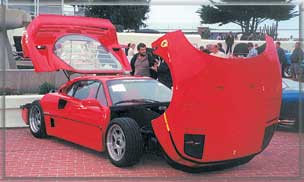SCM Analysis
Detailing
This car sold for $344,300, including commission, at the RM Monterey auction, held August 18, 2001.
The F40 is without a doubt the most exciting street Ferrari to ever come out of Maranello. Its race car level of trim and brutal, turbocharged performance makes even the F50 seem tame. At the same time, the F40 is well mannered, air conditioned and civilized enough to drive around town. Such is its nature —fire and ice in one package.
Laguna Seca Raceway was the scene of my first encounter with an F40 driven in anger. An expertly driven one spanked all of the Ferrari street cars and passed several of the Ferrari race cars. It was elegant yet ferocious, a true descendant of Ferrari’s best offerings.
The next day I saw the same F40 with a middle-aged gentleman piloting an older lady through the Fisherman’s Wharf area of San Francisco. Pointing and talking, he idled the half-million-dollar tour bus through the congested streets. While the 201-mph Ferrari looked totally out of place performing this pedestrian duty, there was no overheating, fouling of spark plugs or embarrassing displays of supercar temperament. I’m sure the owner’s only anxious moments were getting his mother in and out of the deep bucket seats and explaining why he had spent more money on this one car than the total cumulative value of every house she had ever lived in.
Introduced at the height of the 1980s price frenzy, the rampant speculation on the F40 epitomized the era. By the time the F40 hit the US shores the “market” price was already established. While list price was somewhere in the $250k range, European cars were selling for a cool million dollars. American dealers bumped that a bit and started cutting deals. Dealer profits were obscene, but so was the speculators’ greed. A Northeastern dealer reportedly built a new showroom on the profit from their two F40s.
Within months of the first F40 deliveries, the collector car market began to collapse. Speculators walked away from their deposits as the market price slipped under their contracted prices. Dealers adjusted the contracts as the prices fell, but by the time the last new F40s were delivered, they could be bought at list price.
F40s are not rare by Ferrari standards. It was implied that the F40 would be a limited-production model, but with 1,311 cars built, F40 production exceeded every Ferrari model built before it except the Testarossas, Dinos and 308 series cars. As a comparison, there were 1,291 Daytonas, 350 275 GTB/4s and only 272 288 GTOs produced.
Despite its relatively large production, the F40 remains a highly sought-after car. There are very few on the market at any given time. Its dual-purpose race car/collector car status ensures customers for both driver-quality and collector-quality cars. The F40 is a special car that should remain valuable for the foreseeable future. The $344,300 paid for John Copanos’s F40 was a shade less than it might bring today, proving that even in Monterey, and even when spending nearly 350 large, you can still get a bit of a bargain.
